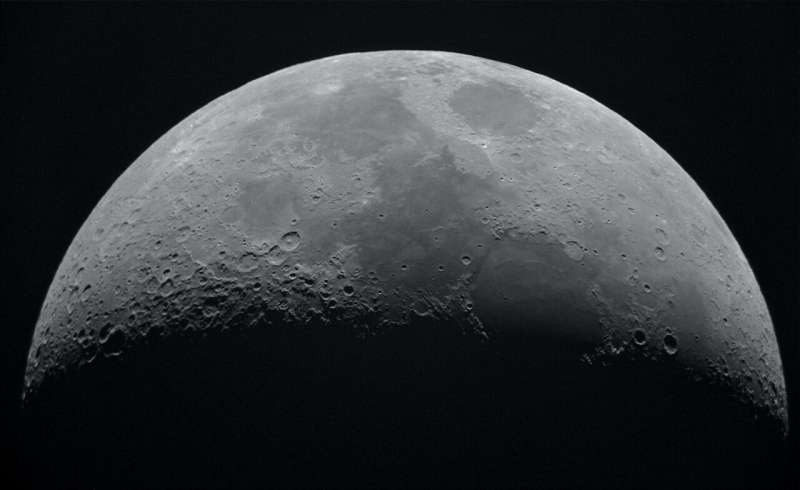Researchers Identify the Source of the Moon’s Thin Atmosphere

August 2, 2024
This article has been reviewed according to Science X's editorial process and policies. Editors have highlighted the following attributes while ensuring the content's credibility:
- fact-checked
- peer-reviewed publication
- trusted source
- proofread
by Jennifer Chu, Massachusetts Institute of Technology
While the moon lacks any breathable air, it does host a barely-there atmosphere. Since the 1980s, astronomers have observed a very thin layer of atoms bouncing over the moon's surface. This delicate atmosphere—technically known as an 'exosphere'—is likely a product of some kind of space weathering. But exactly what those processes might be has been difficult to pin down with any certainty.
Now, scientists at MIT and the University of Chicago say they have identified the main process that formed the moon's atmosphere and continues to sustain it today. In a study appearing in Science Advances, the team reports that the lunar atmosphere is primarily a product of 'impact vaporization.'
In their study, the researchers analyzed samples of lunar soil collected by astronauts during NASA's Apollo missions.
Their analysis suggests that over the moon's 4.5-billion-year history its surface has been continuously bombarded, first by massive meteorites, then more recently, by smaller, dust-sized 'micrometeoroids.'
These constant impacts have kicked up the lunar soil, vaporizing certain atoms on contact and lofting the particles into the air. Some atoms are ejected into space, while others remain suspended over the moon, forming a tenuous atmosphere that is constantly replenished as meteorites continue to pelt the surface.
The researchers found that impact vaporization is the main process by which the moon has generated and sustained its extremely thin atmosphere over billions of years.
'We give a definitive answer that meteorite impact vaporization is the dominant process that creates the lunar atmosphere,' says the study's lead author, Nicole Nie, an assistant professor in MIT's Department of Earth, Atmospheric, and Planetary Sciences.
'The moon is close to 4.5 billion years old, and through that time the surface has been continuously bombarded by meteorites. We show that eventually, a thin atmosphere reaches a steady state because it's being continuously replenished by small impacts all over the moon.'
Nie's co-authors are Nicolas Dauphas, Zhe Zhang, and Timo Hopp at the University of Chicago, and Menelaos Sarantos at NASA Goddard Space Flight Center.
In 2013, NASA sent an orbiter around the moon to do some detailed atmospheric reconnaissance. The Lunar Atmosphere and Dust Environment Explorer (LADEE, pronounced 'laddie') was tasked with remotely gathering information about the moon's thin atmosphere, surface conditions, and any environmental influences on the lunar dust.
LADEE's mission was designed to determine the origins of the moon's atmosphere. Scientists hoped that the probe's remote measurements of soil and atmospheric composition might correlate with certain space weathering processes that could then explain how the moon's atmosphere came to be.
Researchers suspect that two space weathering processes play a role in shaping the lunar atmosphere: impact vaporization and 'ion sputtering'—a phenomenon involving solar wind, which carries energetic charged particles from the sun through space. When these particles hit the moon's surface, they can transfer their energy to the atoms in the soil and send those atoms sputtering and flying into the air.
'Based on LADEE's data, it seemed both processes are playing a role,' Nie says.
'For instance, it showed that during meteorite showers, you see more atoms in the atmosphere, meaning impacts have an effect. But it also showed that when the moon is shielded from the sun, such as during an eclipse, there are also changes in the atmosphere's atoms, meaning the sun also has an impact. So, the results were not clear or quantitative.'
To more precisely pin down the lunar atmosphere's origins, Nie looked to samples of lunar soil collected by astronauts throughout NASA's Apollo missions. She and her colleagues at the University of Chicago acquired 10 samples of lunar soil, each measuring about 100 milligrams—a tiny amount that she estimates would fit into a single raindrop.
Nie sought to first isolate two elements from each sample: potassium and rubidium. Both elements are 'volatile,' meaning that they are easily vaporized by impacts and ion sputtering.
Each element exists in the form of several isotopes. An isotope is a variation of the same element that consists of the same number of protons but a slightly different number of neutrons. For instance, potassium can exist as one of three isotopes, each one having one more neutron, and there being slightly heavier than the last. Similarly, there are two isotopes of rubidium.
The team reasoned that if the moon's atmosphere consists of atoms that have been vaporized and suspended in the air, lighter isotopes of those atoms should be more easily lofted, while heavier isotopes would be more likely to settle back in the soil.
Furthermore, scientists predict that impact vaporization, and ion sputtering, should result in very different isotopic proportions in the soil. The specific ratio of light to heavy isotopes that remain in the soil, for both potassium and rubidium, should then reveal the main process contributing to the lunar atmosphere's origins.
With all that in mind, Nie analyzed the Apollo samples by first crushing the soils into a fine powder, then dissolving the powders in acids to purify and isolate solutions containing potassium and rubidium. She then passed these solutions through a mass spectrometer to measure the various isotopes of both potassium and rubidium in each sample.
The team found that the soils contained mostly heavy isotopes of both potassium and rubidium. The researchers were able to quantify the ratio of heavy to light isotopes of both potassium and rubidium, and by comparing both elements, they found that impact vaporization was most likely the dominant process by which atoms are vaporized and lofted to form the moon's atmosphere.




